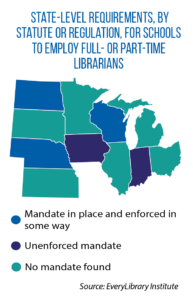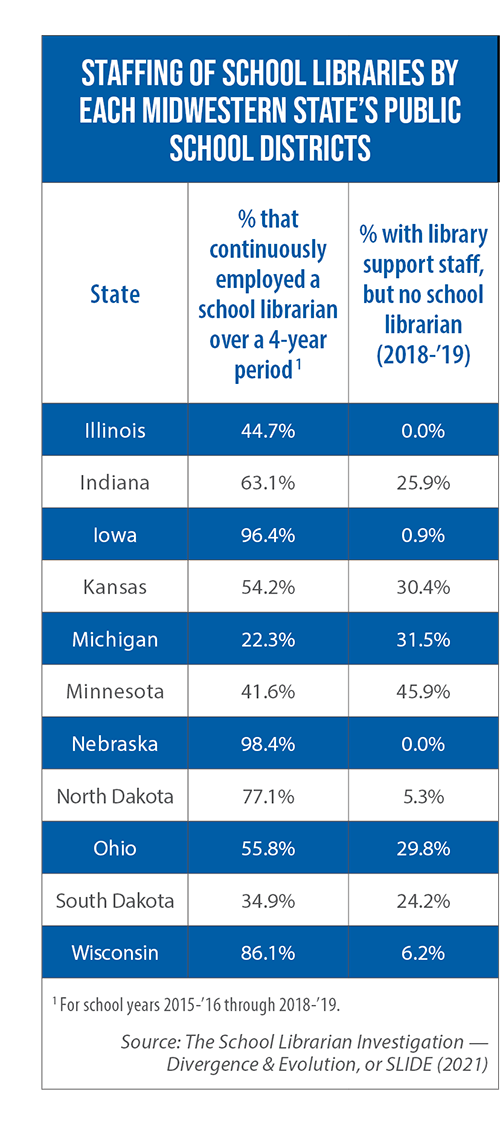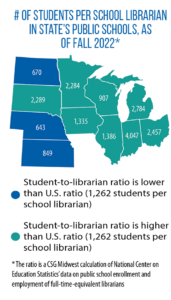School librarians: Integral to learning in some schools, absent in others
The typical American school experience consists of some common traits; recess, field trips, group projects, social cliques and whole-school assemblies, to name a few examples.
For many students, visits to the school library are part of this list as well. It’s where they can find a quiet place to study, learn something new through reading, or take part in a Scholastic Book Fair.
What’s typical for many students, however, is out of reach for others.
More than 12 percent of U.S. public schools didn’t have a library media center in 2020-‘21, according to the National Center for Education Statistics. (The lack of a library is much more prevalent in charter schools compared to traditional public schools.) A separate national study, done by the SLIDE project, estimates that 29.5 percent of U.S. schools didn’t have librarians during that same school year. In the Midwest, the estimate was 32.7 percent.
“As a teacher in a Detroit charter school without a school library, I saw the negative impact of no library and scarce resources on both the staff and students in my school,” Michigan Sen. Darrin Camilleri says.
“We need to help all students have the resources they need to succeed, including grade-level-aligned texts and knowledgeable, accessible school librarians.”
He has introduced bills (SB 741–SB 743) requiring every public school to have a library and to employ at least one librarian, either part-time or full-time depending on student population size.
Under Camilleri’s legislation (still in committee as of October), Michigan schools could seek a state waiver from the librarian mandate. It would be automatically granted to schools/districts with fewer than 51 pupils.
Nebraska: Librarian mandate
Few states in the Midwest mandate that K-12 schools have libraries as well as employ librarians.
One exception is Nebraska. Under current law there, the staffing requirements are scaled based on school size. For example, a school with a population of between 70 and 249 students must have a certified teacher with an endorsement in library sciences who devotes at least one-fifth of his or her time to library media services.
However, even with this state requirement, Nebraska’s school librarians struggle with diminishing budgets, increased responsibilities with limited prep time, and public misinformation about the profession, says Courtney Pentland, a school librarian in Lincoln, Neb.
(Note: Pentland is immediate past president of the American Association of School Librarians; her comments for this article are based solely on her work as a school librarian, not with the association.)
Role in student learning
Pentland compares the role of a school librarian to that of a cruise ship director.
“We’re the person that keeps the ship going in the right direction, but we also have all of these other things that we have to maintain to make sure that we’re serving our population the best way we can,” she says.
In addition to assisting and supervising students, today’s school librarians must act as a cooperative and sometimes lead instructor (for example, as it relates to new literacy education approaches such as the “science of reading”), an academic research expert, a procurement officer, an event planner (given that the physical library space is usually one of the largest rooms in a school), and a media specialist who teaches students to differentiate legitimate sources from disinformation and AI-manipulated content.
Recent research points to the positive academic benefits that full-time certified librarians can have. When analyzing the academic performance of North Carolina students from similar demographic backgrounds, the authors of a 2023 Old Dominion University study found that “students who attend schools with a full-time certified librarian have higher math and reading test scores than students who do not.”
“School librarians see the big picture and help students build on prior knowledge and make connections in ways that may not be available or familiar to classroom teachers,” the authors noted, cautioning that further research was needed to determine some of the most impactful practices used by librarians.
For states that don’t require librarians, Pentland says, library services are usually one of the first areas to get cut. The comparatively higher level of advanced education needed to become a librarian — a master’s degree or, at least, several hours of additional coursework in many states — also makes recruitment efforts a challenge.
And for states that do require school librarians, the job can entail having to juggle dual teaching roles while traveling between multiple schools with limited prep time.
Pentland also says a rise in misinformation about school librarians, and the in-person or online harassment that follows, is causing individuals to leave or give second thought to entering the profession.
According to a 2023 School Library Journal survey, 24 percent of respondents reported harassment in the previous year related to library books or displays. Results from that same survey found that the Midwestern region had the largest share of school librarians who have considered leaving the profession or taking early retirement — 41 percent.
“The [state] bills that have been passed or attempted to be passed that would criminalize librarians and educators for doing their jobs, ones that maybe restrict access to scholarly databases or maybe restrict their ability to purchase materials … it makes some [librarians] question whether it’s worth it,” Pentland says.
Two new laws in Minnesota
Providing more supports for school librarians is among the goals of two new laws in Minnesota.
Last year, as part of its omnibus education bill (HF 2497), the Legislature allocated $1 million for a statewide census of school libraries. Those dollars also are being used to help recruit and retain school librarians through professional development opportunities and tuition assistance for those seeking licensure.
Of the 1,800 schools that had responded to the state survey as of October 2024, 80.6 percent reported having a library media center.
Sen. Mary Kunesh, chief sponsor of the bill and a former school library media specialist herself, says the survey also sought answers to other questions: “What sort of support systems [are] you providing? What support systems are you missing? What kind of collaborative relationships do you have with your county libraries, your state?”
According to Kunesh, policymakers will use the information to help expand library access.
This year, Minnesota legislators created the position of “state school librarian” (HF 5237). This individual will help school librarians across the state develop reading and media literacy curricula, support academic standards, secure grants, access library data collections, and provide guidance on book-removal requests.
Kunesh also envisions the state school librarian evolving into an unofficial legislative liaison, one who can provide a “direct link from the school library media specialist to the Legislature.”